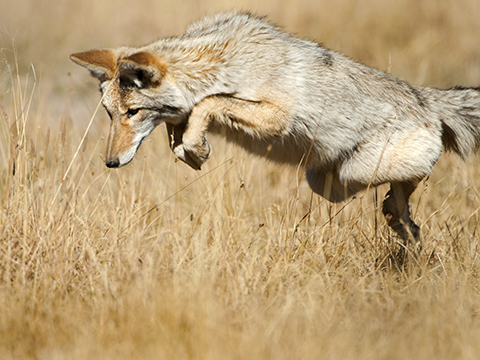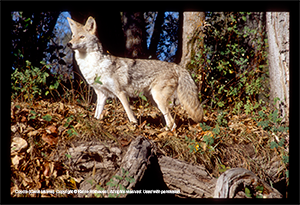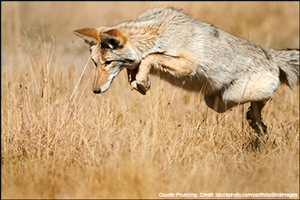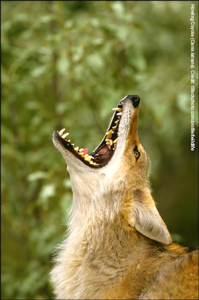Some time ago I took my two young grandsons on a hike in the Great Swamp National Wildlife Refuge. It was a beautiful summer day, with plenty of sunshine. As we walked along a remote trail, my older grandson signaled for us to stop. He pointed to the bushes on the left, to a grey mass of fur that had two bright eyes intently studying us.
“Look granddad, a dog!”
We stopped in our tracks, with our eyes fixed on this furry creature. Was it really a dog? Could it really be someone’s pet, which had strayed deep into the Great Swamp?
My grandson’s next thought was to go and pet the dog. I wasn’t so sure this would be wise. Over the years, animals in nature have always interested me. So, I have read a lot about them. At first, I did wonder if this animal might be a young German shepherd. But as I looked more closely, this creature was not chunky enough in body or legs to be a German shepherd. And, if this were truly a domestic dog, would it not be advancing to us: wagging its tail as if welcoming a long-lost friend? A dog would at least want to come to us and sniff me and the boys.
So, if this was not a dog, what was this creature? Could it be a wolf?!! I remembered that today’s pet dogs had all descended from wolves thousands of years ago, and that some dogs resemble wolves even to this day. But, this animal in front of us was timid and did not have a long-enough snout to be a wolf. In fact, he did not have a large and heavy head, a wide forehead, or the large feet that give wolves such good mobility on snow and ice. Wolves average about 90 pounds in weight, and this creature was maybe half that weight. Then I realized that I was looking at a coyote!! Yes, a coyote right there in the Refuge.
I had read that coyotes had been heard howling—and sometimes even spotted—in the Refuge. Most of us think of the coyote as inhabiting the prairie, deserts and mountains of the western United States, but they are very adaptable animals. They are now found in the eastern states. In fact, a coyote family has even been spotted in Manhattan, among the many red brick buildings known as Stuyvesant Town on the East Side.
Perhaps one reason for the wide geographic presence of the coyote is its indiscriminate appetite. They will eat almost anything! They hunt rabbits, rodents, fish, frogs, and even deer. They also happily dine on insects, snakes, fruit droppings from fruit trees, grass, and carrion. More than just adaptable in diet, the coyote can also change its breeding habits and social dynamics to survive in a wide variety of habitats.
If you have never encountered a coyote, here are some things to consider. They are spindly-legged, but swift. The coyote wears a coat that runs silvery-gray to brown down the back. It is creamy on the belly, and rust-colored on its rangy legs. It sports a low-hanging bushy tail that is black-tipped (much like that of a wolf) and yellowish eyes.
Popular cartoons have made sort of a joke out of coyotes, but I think they are remarkable animals. For one thing, they are formidable hunters in the field. They enjoy keen vision, keen hearing, and a strong sense of smell. They can run up to 40 miles per hour. They are evasive and secretive, so while we may hear them howl, we seldom see them. The coyote often tracks its prey for 20 to 30 minutes before pouncing. It may also take advantage of its stamina to chase its prey over long distances, and then strike when the once it is exhausted.
While the human rarely sight coyotes, it is not unusual to hear them at night. At night, coyotes both howl (a high-quavering cry) and emit a series of short, high-pitched yips. Howls are used to keep in touch with other coyotes in the area. This howl is said to be an announcement that:
“I am here and this is my area. Other males are invited to stay away, but females are welcome to follow the sound of my voice. Please answer and let me know where you are so we don’t have any unwanted conflicts.”
These calls are made throughout the year, but they are most common during the spring mating season, and in the fall when the pups leave their families to establish new territories.
Just then, we heard a high, quavering howl in the distance. My boys guessed right and said perhaps this was a call summoning our new coyote friend. The coyote turned his head toward the howling and slipped out of sight, deeper into the bushes, and was gone.
Now, the sun was beginning to dip below the tree line. I reminded the boys that their dinner probably was waiting for them. But, I had to leave them with some grandfatherly advice:
“Remember, boys, if you ever encounter a coyote, you just want to avoid misunderstanding. If the coyote approaches you, you want to act big and make loud noises. Coyotes are curious but timid animals, and will generally run away if challenged. However, remember that any wild animal will protect itself or its young. For emphasis you can wave your arms, throw stones and, shout at the animal. If necessary, make yourself appear larger by standing on a big rock, stump, or stair. The idea is to convince the coyote that you are not prey, but a potential danger.”




Thanks for the advice, I am personally try to figure out if their is a FOX or COYOTE or ? running past my RING DOORBELL , spotted two or three late evenings, L
or COYOTE or ? running past my RING DOORBELL , spotted two or three late evenings, L
 KS FOX
KS FOX  LIKE however the TAIL is is very thin,could it have mange disease
LIKE however the TAIL is is very thin,could it have mange disease